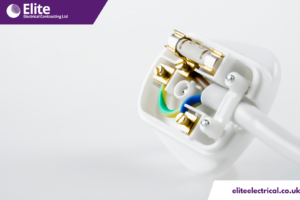Main Categories of Electrical Services
Power Distribution Systems
Components: Includes circuit breakers, fuses, and electrical panels.
Purpose: Ensures safe and efficient distribution of electricity throughout a property, preventing overload and potential hazards.
Lighting Systems
Varieties: Features LED, fluorescent, and incandescent options.
Usage: LEDs are best for energy efficiency and longevity, fluorescents are preferred in offices and schools for their bright and wide coverage, and incandescents are ideal for warm, ambient lighting.
HVAC Systems
Components: Comprises heat pumps, electric furnaces, and air conditioners.
Functionality: Provides temperature control and improves air quality, with smart technologies for enhanced energy efficiency.
Communication Systems
Technologies: Utilises fibre optics and copper cabling.
Applications: Fibre optics offer high-speed data transmission ideal for internet and telecom; copper remains a cost-effective choice for shorter-distance data and voice communications.
Specialised Electrical Installations
- Innovations: Covers less common but equally important services like solar power installations, custom lighting solutions for commercial properties, or advanced security system installations.
- Applications: These specialised services cater to specific needs that go beyond traditional electrical installations, providing enhanced functionality and efficiency.
Detailed Overview of Electrical Types
Electrical services encompass a broad range of essential functions, crucial for both residential and commercial environments. These services facilitate everything from the basic distribution of power to sophisticated systems for lighting, heating, cooling, and communications. Understanding the various types of electrical services is not merely a matter of convenience—it is a safeguard against inefficiencies and potential exploitation. By gaining knowledge of what electrical services you require, why they are necessary, and when they should be implemented, you can ensure that your electrical systems are not only efficient but also tailored to meet your specific needs.

Power Distribution Systems: Essential Components and Functions
Introduction
Power distribution systems are crucial in any residential or commercial building, responsible for managing and delivering electricity safely and efficiently across various endpoints. Understanding these systems is vital for effective power management and ensuring safety standards are met.
Components of Power Distribution Systems
- Circuit Breakers: These are safety devices designed to protect an electrical circuit from damage caused by excess current from an overload or short circuit. Their basic function is to interrupt current flow after protective relays detect a fault.
- Fuses: Acting as a sacrificial device, fuses protect circuits from overcurrent. They contain a metal wire or strip that melts when too much current flows through it, thereby interrupting the flow of electricity.
- Electrical Panels: Also known as distribution boards, these panels house the fuses or circuit breakers where the electrical energy, which enters a property, is divided into subsidiary circuits. They provide a central place to manage circuit breakers and fuses.
Purpose and Functionality
- Safety and Efficiency: Power distribution systems are engineered to distribute electrical power efficiently throughout a property while minimising the risk of electrical fires and other hazards. They ensure that the electrical supply is properly managed and distributed to various sectors of a building without overloading the system.
- Preventing Overloads: By regulating the amount of electrical current that flows through each circuit, these systems prevent circuit overload, protecting appliances and preventing potential electrical fires.
- System Monitoring: Modern power distribution systems often include monitoring capabilities that help detect inefficiencies and potential problems in the electrical grid, allowing for quick corrections and maintaining system health.
Importance in Power Management
- Understanding Electrical Types: Knowing the different components and their functions within power distribution systems is essential for anyone involved in electrical engineering or maintenance. It aids in diagnosing issues, planning new electrical installations, or upgrading existing systems.
Key Takeaways
Power distribution systems form the backbone of electrical infrastructure in any property. Their efficient and safe operation is critical to prevent electrical issues and ensure a reliable power supply. Understanding these systems’ components and functions helps in maintaining operational integrity and safety standards, essential for both residential and commercial properties.

Lighting Systems: Enhancing Spaces with Varied Illumination Options
Introduction
Lighting systems are a fundamental aspect of electrical services, offering a range of solutions tailored to meet the diverse needs of different environments. From residential homes to large commercial spaces, the choice of lighting can significantly impact both the functionality and the aesthetic of an area.
Varieties of Lighting Systems
- LEDs (Light Emitting Diodes): Known for their efficiency and longevity, LEDs are a popular choice for both residential and commercial use. They consume less power and can last significantly longer than traditional bulbs, making them a cost-effective and environmentally friendly option.
- Fluorescent Lighting: Commonly used in offices, schools, and industrial spaces, fluorescent lights are favoured for their bright and widespread illumination. They are more energy-efficient than incandescent bulbs and provide excellent coverage, making them ideal for large, open areas.
- Incandescent Bulbs: Preferred for their ability to produce warm, inviting light, incandescent bulbs are often used in settings where ambience is a priority. Despite being less energy-efficient, they are cherished for their classic appearance and the cosy glow they emit.
Usage and Applications
- LEDs: Perfect for almost every setting, from domestic kitchens and living rooms to commercial showrooms and streetlights. Their versatility also extends to smart home systems, where they can be controlled and customised to change brightness and colour.
- Fluorescent Lights: Ideal for educational institutions and workplaces due to their large area coverage and bright light, which helps in reducing eye strain and improving productivity.
- Incandescent Lights: Best suited for areas requiring mood lighting, such as dining rooms, lobbies, and boutique spaces, where a softer light enhances the overall ambience.
Importance in Electrical Types
Understanding the different types of lighting systems is crucial for effective power management and design aesthetics. Each lighting type serves specific roles, from enhancing energy efficiency to contributing to the decor and mood of a space. By selecting the appropriate lighting solution, one can drastically improve the usability and appearance of any environment.
Key Takeaways
Choosing the right lighting system involves considering both the functional needs and the desired atmosphere of a space. LEDs, fluorescents, and incandescents each offer unique benefits that can enhance both the efficiency and the aesthetic appeal of a property. Knowledge of these options allows for informed decision-making, ensuring that each room not only looks appealing but also operates at optimal efficiency.
HVAC Systems: Key Components and Functionalities for Optimal Climate Control
Introduction
HVAC (Heating, Ventilation, and Air Conditioning) systems are critical components in residential, commercial, and industrial buildings, providing essential climate control and contributing to indoor air quality. These systems are designed to offer comfort and enhance energy efficiency through advanced technological integrations.
Components of HVAC Systems
- Heat Pumps: Serve dual purposes, providing heating and cooling to buildings by extracting heat from the outside air or ground and transferring it indoors during cold months, and vice versa during warm months.
- Electric Furnaces: Use electric heating elements to produce heat, which is then distributed throughout a building via a system of ducts. They are particularly effective in areas where electricity is the primary energy source for heating.
- Air Conditioners: Essential for cooling indoor spaces by removing heat and humidity from the interior air. They are crucial in enhancing comfort levels during warmer seasons.
Functionality and Efficiency
- Temperature Control: HVAC systems are engineered to maintain desired temperature settings within a building, ensuring comfort regardless of outside weather conditions.
- Air Quality Improvement: By regulating airflow and filtering out pollutants and allergens, these systems significantly improve indoor air quality, which is vital for health and well-being.
- Energy Efficiency: Modern HVAC systems incorporate smart technologies such as programmable thermostats and inverter technology, which optimise energy use and reduce costs. These smart-systems adjust heating and cooling automatically based on real-time environmental and occupancy changes.
Importance in Electrical Types
HVAC systems exemplify sophisticated electrical types in climate control technologies, showcasing the integration of electrical engineering principles with thermal dynamics. They not only enhance living and working environments but also emphasise the importance of energy efficiency and technological advancement in modern building management.
Key Takeaways
Understanding the different components and functionalities of HVAC systems is essential for anyone involved in building management, maintenance, or construction. These systems play a crucial role in providing comfortable and healthy indoor environments, and their efficient operation can lead to significant energy and cost savings. The right HVAC system, tailored to the specific needs of a property, can greatly improve the quality of life for its occupants and contribute to the sustainability goals of the facility.

Communication Systems: Essential Technologies for Modern Connectivity
Introduction
In the digital age, communication systems are fundamental to connectivity in both personal and professional settings. These systems utilise advanced technologies to manage data transmission and ensure reliable communication across various platforms.
Technologies in Communication Systems
- Fibre Optics: Utilises thin strands of glass or plastic fibres to transmit data as light signals. Fibre optics is renowned for its high-speed data transmission capabilities, making it ideal for internet backbones, telecommunications, and high-speed data networks. The technology allows for vast amounts of data to be sent over long distances at speeds much faster than traditional metal communications lines.
- Copper Cabling: Traditional yet still widely used, copper cables transmit electrical signals using metal (copper) wires. While not as fast as fibre optics, copper cabling is cost-effective and sufficient for many applications, particularly in residential internet connections and internal networking where high speeds are not as critical.
Applications and Practical Uses
- Fibre Optics Applications: Due to its high bandwidth and speed, fibre optics is predominantly used in scenarios requiring rapid data transmission, such as broadband internet services, data centre connections, and long-distance telecommunications. It is also used in medical imaging and automotive safety systems due to its ability to transmit without electromagnetic interference.
- Copper Cabling Applications: Copper is commonly employed for telephone wiring, cable television systems, and traditional Ethernet networks. Its utility in providing voice communications and internet services at a lower cost makes it a viable option for many businesses and homes.
Importance in Electrical Types
Communication systems demonstrate the significant evolution in electrical technologies, adapting to the needs of modern infrastructure. The use of both fibre optics and copper cabling highlights the variety of electrical types available for different communication needs, from basic voice transmission to complex data and video streaming across global networks.
Key Takeaways
The integration of various technologies in communication systems underscores the dynamic nature of electrical engineering in the context of global connectivity. By understanding the specific applications and advantages of each type of technology, businesses and consumers can make informed decisions tailored to their communication needs. This knowledge is crucial for anyone involved in the planning, implementation, or management of communication networks.
Specialised Electrical Installations: Innovations in Modern Electrical Services
Introduction
Beyond the standard electrical services, there are specialised installations that cater to specific needs and advanced functionalities. These services not only enhance efficiency but also bring modern technological advancements into both commercial and residential spaces.
Types of Specialized Electrical Installations
- Solar Power Installations: As the demand for renewable energy sources increases, solar power installations have become more prevalent. These systems involve the setup of solar panels to capture energy from the sun, converting it into electricity for immediate use or storage in batteries for later use. This technology not only reduces dependency on traditional power grids but also offers significant cost savings over time.
- Custom Lighting Solutions for Commercial Properties: Tailored lighting systems are designed to meet the unique needs of commercial spaces, such as retail stores, galleries, and office buildings. These solutions often include advanced features like motion sensors, energy-efficient LEDs, and smart controls that can adjust lighting based on the time of day or occupancy levels, enhancing both aesthetic appeal and energy efficiency.
- Advanced Security System Installations: Modern security systems integrate a variety of technologies, including CCTV cameras, motion detectors, and access control systems. These installations are crucial for ensuring safety and security in high-risk areas or properties requiring high levels of protection. Advanced systems can be networked to provide real-time monitoring and alerts, ensuring rapid response to any security breaches.
Importance in Electrical Types
Specialised electrical installations represent the cutting-edge of electrical technology, combining traditional practices with modern innovations. They are crucial for:
- Energy Efficiency: Many specialised installations are designed to optimise energy use, which is essential in today’s energy-conscious world.
- Enhanced Security: Advanced security installations safeguard against theft and unauthorised access, providing peace of mind for property owners.
- Customization: Custom lighting solutions allow for environmental personalization, crucial for branding and creating specific moods or atmospheres in commercial settings.
Key Takeaways
Specialised electrical installations are integral to modern electrical engineering, offering solutions that standard electrical services cannot. Whether it’s harnessing solar energy, enhancing property aesthetics with custom lighting, or securing premises with sophisticated security systems, these installations push the boundaries of what electrical systems can provide. Understanding these options allows users to make informed decisions that align with their specific needs, ensuring functionality and efficiency are maximised.

Connect with Elite Electrical Contracting Ltd
If you’re looking to upgrade your property’s electrical systems or need tailored solutions that align with the latest technological advancements, Elite Electrical Contracting Ltd is here to help. Our team of experienced professionals is dedicated to providing top-notch service and innovative solutions across London and Surrey. Whether it’s a custom lighting installation for your new office or a comprehensive security system for your home, we ensure perfection and reliability in every project.
Don’t settle for less when it comes to your electrical needs. Contact Elite Electrical Contracting Ltd today to discuss how we can bring our expertise to your project and ensure your electrical systems are not only efficient but also future-proof. Visit our website, or reach out directly to our customer service team. Let us help you achieve the perfect balance of style, functionality, and safety with our specialised electrical services.
- Address: 30 Upper Mulgrave Road, Sutton, Surrey, SM2 7BD
- Phone: 020 8644 3200
- Fax: 020 8644 3300
- Email: [email protected]
Choose Elite Electrical Contracting Ltd and experience electrical services that go beyond expectations. Let’s illuminate your space together!







